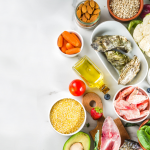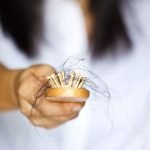Supporting Busy Women Lifestyle, Diet, & Medicinal Food
Jillian Stansbury, ND
Botanical Insights
My practice is filled with busy women who are struggling to work, manage a household, stay fit, and juggle many roles, from careers and families to personal interests and just the basic tasks of life. When the women I work with show an interest in herbs, cooking, classes that I teach, and saving money on supplements, the following recipes are a few handouts that I keep on hand to share. I also print some out on attractive recipe cards to offer as a free and supportive perk, and have them available in my waiting room and apothecary. I would love to see your favorite recipes and handouts too. Feel free to email me and I will be happy to share with everyone in a future article.
Radish Sprouts as a Source of DIM
Glucosinolates are believed to support detoxification pathways, as well as inhibit cancer cell proliferation, according to specific research on breast cancer.1 Radishes, especially radish sprouts and black radishes, contain more glucosinolates than other crucifers.2 These compounds are commonly referred to as DIM (or diindolylmethane) and cost pennies compared to a pill supplement. I especially encourage radishes and DIM for men and women with hormonal reproductive cancers, and women with any manner of hyperestrogenism, such as fibrocystic breast disease, uterine fibroids, endometriosis, and severe PMS. It is recommended to eat 1 cup/day, which is easily accomplished by mixing into salads, topping beans or cooked vegetables with the raw sprouts, or even liquefying in various smoothies.
- Radish seeds: 1 tbsp
- Pure water: 2 cups
- Sprouting jar or tray
Soak seeds overnight, drain and rinse in the morning while storing in a dark cupboard. Rinse 2 to 3 times per day faithfully. When the first tiny leaves emerge, place in a sunny window and continue to rinse 2 times per day. Once the leaves are fully green, remove from the sprouter and place in the refrigerator. Use over 48 hours while starting a new batch.
Fucus “Chips” for Hypothyroidism
Seaweed is an excellent source of iodine and other minerals. For those who enjoy or at least tolerate the flavor of seaweed, this snack can replace chips, crackers, and other starches to help those with hypothyroidism, metabolic syndrome, frank diabetes, or PCOS to lose weight. Fucus can be purchased dry from herb suppliers and eaten as is, as an easy source of iodine, or mixed with nuts and seeds, as in this recipe, for a healthier alternative to chips and crackers.
- Fucus, large pieces, if possible: 2 cups
- Almonds, raw, slivered: 1 cup
- Pistachios, raw, crushed: 2 cup
Simply combine the unsalted nuts and seaweed in a bowl and blend, then transfer to small snack bags. Eat 1 to 2 handfuls (1/2 cup) each day.
Salad of the Sea
Here is an example of using seaweed in cooking. The salty, slightly fishy flavor lends itself well to seafood recipes. This recipe also includes medicinal spices, plenty of vegetables, and quinoa – a gluten-free “pseudograin” – instead of the more traditional rice or noodle Asian stir fries.
- 1 yellow onion, chopped
- 3 cloves garlic, fresh, minced
- 1 tbsp ginger, fresh, minced
- 1/4 cup red bell pepper, diced
- 1/4 cup yellow bell pepper, diced
- 1/4cup dried seaweed (eg, dulse) or 1/2 cup fresh
- 1/2 cup sprouts, fresh
- 1/2 cup carrots, grated
- 1/2 cup toasted nuts
- 1 cup cooked shrimp (may substitute scallops)
- 1 cup quinoa, cooked
- 1/4 cup sesame oil
- 1/4 cup tamari
- 1/4 cup honey or agave nectar
- Juice and zest of 1 lime
- Pinch of cayenne
PhytoEstrogen Tea
Phytoestrogens are natural compounds from plants that are able to bind to estrogen receptors and elicit a variety of hormonal effects. Because many types of breast1 and prostate2 cancer involve altered and excessive hormonal stimulation of these organs, phytoestrogens may be an important tool for improving hormonal balance in these cancers. Genes that control cellular and hormonal receptor quantities and response are also shown to be unfavorably influenced by exogenous chemicals3,4 and favorably influenced by phytoestrogens.5,6 These herbs all have additional medicinal virtues and are tasty enough to enjoy on a regular basis.
- Trifolium pratense (red clover): 1 oz
- Medicago sativa (alfalfa): 1 oz
- Urtica dioica (stinging nettle): 1 oz
- Camellia sinensis (green tea, black tea): 1 oz
- Humulus lupulus (hop): 1 oz
- Glycyrrhiza glabra (licorice): 1 oz
Mix the herbs and store in an air-tight container. Steep 1 tbsp of the herbal mixture per cup of hot water for 10 minutes, strain, and drink freely. This tea may simply be enjoyed as a preventative, or used at a dose of 3 or more cups per day in an attempt to reduce estrogen dominance.
Dairy-Free Isoflavone Bean Chowder
Beans are also a source of isoflavones and are high in fiber. I have a collection of bean recipes and I encourage people to eat at least 1 legume every day to support hormonal balance, reduce cholesterol, improve insulin resistance and blood sugar regulation, and support a health intestinal ecosystem. In this recipe, pureed navy beans create a white and creamy texture, yet the delicious “chowder” is dairy-free.
- 3 cups dry white navy beans
- 1-2 cartons soy milk
- 1 can pinto beans, rinsed and drained
- 1 can red kidney beans, rinsed and drained (or fresh peas when available)
- 1 large onion, diced
- 4 large garlic cloves, minced
- 1 cup shiitake mushrooms, chopped
- 1/2 package (~5 slices) turkey bacon, cut into small pieces (optional)
- 1 12-oz can of clams with juice
- 2 carrots, chopped
- 2 stalks celery, chopped
- 2 ears fresh sweet corn, kernels cut from cob; save the cobs
- 1 large potato or yam, chopped into small pieces
- 2 tbsp olive oil
- 2 tbsp miso paste
- 1 tsp dry thyme
- Salt
- Pepper
- Fresh parsley, chopped, added in last 10 minutes of cooking or at serving time
Soak 3 cups of white navy beans overnight in water. Strain and rinse in the morning, place in a large saucepan, add fresh water and simmer until soft. Rinse again, drain, and place in a blender or food processor with 3 or more cups of soy milk until it becomes a grainy puree.
Place corn cobs in 4 cups water and gently simmer for 30 minutes. Remove cobs and scrape remaining cord debris into the water, using the edge of spoon.
Place chopped onion, garlic, bacon, clams, and shitake mushrooms in the saucepan with miso paste and olive oil, and heat until onions are translucent, stirring occasionally. Add the white bean puree and the corn water. Add rinsed pinto beans, corn, potato, and carrots. Add salt and pepper to taste. Add additional soy milk to maintain liquid. Gently simmer, covered, around 1 hour, stirring occasionally.
When carrots are tender, reduce heat until ready to serve. Top each bowl with finely chopped parsley at serving time. Serve with fresh salad and cornbread, or crusty French bread.
This recipe makes a full crockpot of chowder and may be cooked via this method as well, after pureeing the navy beans. The recipe may be halved for a smaller quantity. The turkey and clams may be omitted to prepare a vegetarian version.
Summer Tea for Metabolic Support
This tea provides a great deal of chromium and is cooling and refreshing. Hibiscus is the highest known source of chromium, offering blood sugar balancing effects. Medicago is high in isoflavones and chiro-inositol compounds, both of which show benefit in supporting healthy blood sugar and lipid metabolism. The tea is especially nice in the summer due to its sour flavor and cooling effects.
- Medicago sativa: 6 oz
- Stevia: 2 oz
- Hibiscus: 2 oz
Combine equal parts of the dry herbs in a jar or airlock bag. Steep 1 tbsp of the herbal mixture per cup of boiling water for 10 minutes, then strain the brew and drink as desired. It can also be chilled and served cold or over ice if desired.
Makes: 1 cup of tea per tbsp of herbs used
Serving Size: 1 cup
Winter Tea for Metabolic Support
These blood sugar balancing herbs are slightly warming and a welcome drink on a chilly day. Astragalus is a legume, supplying inositol compounds that improve insulin resistance, and also offers immune support against winter colds and flu.
- Astragalus root, shredded: 5 oz
- Glycyrrhiza root, shredded: 2 oz
- Cinnamomum bark, small chunks: 2 oz
- Fenugreek seeds: 1 oz
Combine the dry herbs in a jar or ziplock bag. Use 1 tsp of the blend per cup of water. Simmer gently for 10 minutes, let stand 10 minutes or more, and strain. Drink freely.
High Flavone FruitsBecause of all the bright red and purple pigments, these fruits have protective and anti-inflammatory effects for blood vessels. They are good choices for making herbal fruit waters, vinegars, and dressings. Use to make herbal vinegars fruit waters, and desserts. · Punica granatum (pomegranate) · Prunus spp (black cherry) · Vitis vinifera (grapes) · Vaccinium myrtillus (blueberry) · Opuntia spp (prickly pear) |
Agua de Manzana (Apple Water)
“Agua de” means “water of…” in Spanish, and such waters are prepared by simply simmering fruit, quinoa, or other foods in water, like making a tea. Manzana means apple, and this apple “tea,” or Agua de Manzana, is something that my time in Peru has given me an appreciation for. Some recipes also include quinoa or oats or barley. A dilute preparation of this mixture is popular as a breakfast drink, similar to a very thin porridge. The preparation couldn’t be simpler. Make a pitcher every morning, refrigerate, and watch it disappear. Another variation is to use an herbal tea in place of the water, for added medicinal effects.
- 2 organic apples
- 1/2 cup quinoa
- Spring water (pitcher)
Cut the apples into small chunks and place in the bottom of a pitcher. Cover with high-quality water, heat to a simmer, then refrigerate until cold. In Peru, people leave the seeds and other particulate in the water and just let it settle on the bottom of the pitcher. If this troubles you, you may strain it a bit after 2 or 3 hours in the fridge.
Makes: 1 pitcher
Serving size: 2 cup glass
Herbal Sipping Vinegar and Spritzers
Sipping vinegars employ homemade balsamic, rice, wine, or apple cider vinegars by macerating mangos, papayas, citrus zest, high-mineral herbs, or other medicinal foods and herbs, prepared by macerating the chosen ingredients for 4 to 6 weeks and pressing out. Macerating hot and spicy foods and herbs in vinegar is often referred to as “Fire Cider” and is featured in the next recipe. The resulting vinegars are prepared into drinks by diluting with water, sparkling water, a dash of fruit juice, rose water, honey, or even alcohol for holiday and other celebratory drinks. Vinegars enhance digestion and have a cooling effect on the body.
- Fruit/Herbal vinegar: 1 tbsp (15 mL)
- Rose water: 1 tbsp (15 mL)
- Sparkling mineral water: 2 cups (500 mL)
- Ice cubes
Garnish variations: Forzen cranberries or blueberries (just 3 or 4 in each glass); lemon twists
Fire “Cider”
This apple cider maceration is fiery due to the hot spices it contains. Fire cider is a classic herbal remedy to treat the immune system, stimulate circulation, and enhance digestion for those with hypochlorhydria. The finished pressed vinegar can be taken by the spoonful when coming down with a cold, used to prepare an aperitif with hot water, honey and lemon, or used to make salad dressings and marinades by combining with olive oil and fresh vegetables such as tomatoes, papayas, avocados, nuts, or feta cheese.
- 1 horseradish, 6-inch length, peeled and chopped into blender-friendly pieces
- Garlic, 1 whole bulb, separated into peeled cloves
- 1 yellow onion, coarsely chopped
- 12 habanero peppers, coarsely chopped; leave the seeds for a hotter vinegar
- Ginger root, fresh, coarsely chopped into blender-friendly pieces
- Turmeric root, coarsely chopped into blender-friendly pieces
Combine all the fresh spices in a high-speed blender, and cover with apple cider vinegar or other vinegar of choice. Puree as finely as possible and transfer to several large 1/2 gallon canning jars. Allow the marc (chopped herbs) to settle, and top off with additional vinegar as needed. Other variations include adding dried black pepper, dried garlic or onion flakes, or lemon peels and juice (or other organic citrus peels and their juice). Shake the canning jar every day for 4-6 weeks, strain once through a wire mesh strainer, and a second time through a jelly bag, nut milk strainer, or other muslin or cheese cloth strainer. Transfer to glass bottles. The finished medicinal cider will store for several years and does not require refrigeration.
Almond Milk
This delicious milk substitute is easy to make, and has less fat than regular milk, with no saturated fat and no cholesterol. (Dairy products may also contain added hormones and drug residues, contributing to hormonal imbalance in women with PCOS.) Almonds are one of the least fatty nuts. Save the almond meal to use in other recipes.
- Raw almonds (this will not work with toasted almonds): 3 cups (750 mL)
- Boiling water, or hot Stevia Tea for a sweeter version: 6 cups (1.5 L)
Pour several cups of boiling hot water over raw almonds and let sit overnight, 1 full day if possible. The almonds will swell overnight and soak up most of the water. Place the soaked almonds in a blender, add 6 cups of fresh spring water, and puree as finely as possible. If you like, you may leave the fine nut particulate in the “milk” if you are going to use it to make a smoothie or pour over oatmeal or fresh fruit. Otherwise, place the entire blended liquid into a muslin bag or fine mesh strainer, and strain the liquid to remove all particulate. You may use the particulate elsewhere if desired, such as in muffin recipes, or freeze for later use. You may also sweeten this milk, if desired, with a bit of stevia tea or agave nectar.
Warm Almond Nutmeg Milk
This works well as a breakfast, or as a chilly evening dessert. Another variation I sometimes indulge in is adding a shot of espresso. Arrowroot powder makes the milk thicker and creamier, and the maca powder adds medicinal value.
- Almond milk (as listed above): 3 cups (750 mL)
- Maca powder: 3 tbsp (45 mL)
- Agave nectar: 1 tbsp (15 mL)
- Arrowroot powder: 2 tsp (10 mL)
- Freshly grated nutmeg powder: 1/2 tsp (2 mL), or 1/4 tsp dry
Place the maca and arrowroot powders in the bottom of a sauce pan, and add the agave nectar and just 1-2 tbsp of the almond milk. Use a fork to thoroughly moisten the powder, and continue adding more milk, 1 tbsp at a time, to avoid getting lumps of maca in the milk. Continue thinning down the maca and arrowroot with the almond milk until all has been added. Gently heat the milk over low heat until a very gentle simmer is reached. Take it off of the heat immediately and stir for several minutes as the arrowroot begins to thicken the milk. Ladle into mugs and add a pinch of fresh grated nutmeg to each.
References:
- Subramanian A, Salhab M, Mokbel K. Oestrogen producing enzymes and mammary carcinogenesis: a review. Breast Cancer Res Treat. 2008;111(2):191-202.
- Auricchio F, Migliaccio A, Castoria G. Sex-steroid hormones and EGF signalling in breast and prostate cancer cells: targeting the association of Src with steroid receptors. Steroids. 2008;73(9-10):880-884.
- Li L, Andersen ME, Heber S, Zhang Q. Non-monotonic dose-response relationship in steroid hormone receptor-mediated gene expression. J Mol Endocrinol. 2007;38(5):569-585.
- Payen L, Sparfel L, Courtois A, et al. The drug efflux pump MRP2: regulation of expression in physiopathological situations and by endogenous and exogenous compounds. Cell Biol Toxicol. 2002;18(4):221-233.
- Hsieh TC, Wu JM. Targeting CWR22Rv1 prostate cancer cell proliferation and gene expression by combinations of the phytochemicals EGCG, genistein and quercetin. Anticancer Res. 2009;29(10):4025-4032.
- Bliedtner A, Zierau O, Albrecht S, et al. Effects of genistein and estrogen receptor subtype-specific agonists in ArKO mice following different administration routes. Mol Cell Endocrinol. 2010;314(1):41-52.
 Jillian Stansbury, ND, has practiced in SW Washington for nearly 20 years, specializing in women’s health, mental health, and chronic disease. She holds undergraduate degrees in medical illustration and medical assisting, and graduated with honors in both programs. Dr Stansbury also chaired the botanical medicine program at NCNM and has taught the core botanical curricula for more than 20 years. She also writes and serves as a medical editor for numerous professional journals and lay publications, and teaches natural products chemistry and herbal medicine around the country. She is presently working to set up a humanitarian service organization in Peru and is studying South American ethnobotany. She is the mother of 2 adult children, and enjoys art, music, gardening, camping, international travel, and the study of quantum and metaphysics.
Jillian Stansbury, ND, has practiced in SW Washington for nearly 20 years, specializing in women’s health, mental health, and chronic disease. She holds undergraduate degrees in medical illustration and medical assisting, and graduated with honors in both programs. Dr Stansbury also chaired the botanical medicine program at NCNM and has taught the core botanical curricula for more than 20 years. She also writes and serves as a medical editor for numerous professional journals and lay publications, and teaches natural products chemistry and herbal medicine around the country. She is presently working to set up a humanitarian service organization in Peru and is studying South American ethnobotany. She is the mother of 2 adult children, and enjoys art, music, gardening, camping, international travel, and the study of quantum and metaphysics.










